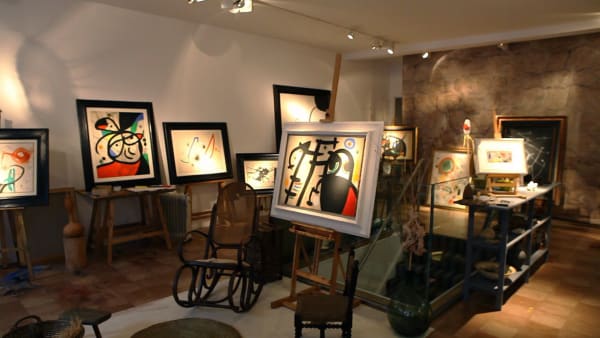“My dream, once I am able to settle down somewhere, is to have a very large studio.”
- Joan Miró, 1938
Celebrating the 60th anniversary of the foundation of Joan Miró’s studio in Mallorca, in 1956, Mayoral presents an immersive exhibition recreating this important atelier in art history.
The historically accurate reconstruction includes 22 paintings and drawings dating from the years Miró was working in the studio. It also contains the correspondence between Miró and Sert relating to the conception of the studio in the 1950s; photographs and archive footage relating to Miró’s working process; as well as furniture, painting materials, household items, and the personal effects of the artist. The exhibition offers real insight into the everyday life of the great avant garde painter.
It could be suggested that there were two crucial moments that served as turning points in Miró’s artistic career. The first was when he was young and travelled to Paris. He immersed himself in Dadaism and Surrealism and through these movements, integrated himself into the world of poets on Rue Blomet studio. Here, he experienced an intellectual awakening which can be identified in his development of poetic iconography. The second moment took place years later, on the foundation of the studio: after working in many different places, in 1956, his dream for a large studio finally became a reality.
The studio was designed by Miró’s close friend and well known Catalan architect, Josep Lluís Sert, who went on to design Miró´s Foundation in Barcelona, nineteen years later, in 1975. Working from exile in New York, Sert corresponded with Miró about the design of the workshop through a series of letters. These important documents are included in a second space of the exhibition, where visitors can learn more about the extraordinary artistic output of Miró.
The new studio introduced new challenges for the artist. In the words of curator Elvira Cámara “Now that the studio in Palma was finished […] Miró, already an older man, had to get used to the new space. The period of adjustment was more mental than physical and while waiting for the studio to be finished, being a tireless worker, Miró explored other art forms such as pottery, engraving and lithography.”
Thanks to the new space in Mallorca, Miró could exercise his creative freedom, with the chance to
work on huge sized canvases and to use new materials. One example is Painting (1977). The enormous studio became an experimental place for new artistic processes and techniques, reflected immediately in his work, as well as a refuge from the world outside.
The new space was a multifaceted world for Miró, not only for creating, but also as a museum for objects, one of his main sources of inspiration. As Joan Punyet Miró says: “Flowing together in Miró is an imaginative inspiration and fantasy that comes from a number of different sources. First and foremost among them are the very objects […] various small figurines and toys, interesting stones, woven palm leaves from Palm Sunday, photos, prints, postcards, and the most varied paraphernalia imaginable. All this helped (though not always immediately, which made it worthwhile keeping hold of those objects just in case) to find inspiration and give rise to a painting, whose subsequent result would also have something to do (or not) with the material that had served as its starting point.”
Miró worked in the studio of Son Abrines for over a quarter of a century, until his death in 1983.
The exhibition is curated by Elvira Cámara and produced by Joan Punyet Miró (the artist’s grandson) in collaboration with Mayoral, a Barcelona-based gallery specializing in museum quality, post war and modern art.
Exhibited at Duke Street, 6, St James’s, SW1Y 6BN London.












